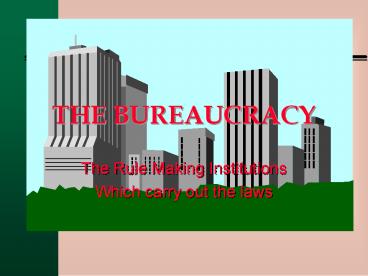THE BUREAUCRACY - PowerPoint PPT Presentation
Title:
THE BUREAUCRACY
Description:
... policy is put into operation Iron Triangles and Issue Networks Interest ... that could be done by the private sector ... Eliminate agency budget or ... – PowerPoint PPT presentation
Number of Views:150
Avg rating:3.0/5.0
Title: THE BUREAUCRACY
1
THE BUREAUCRACY
- The Rule Making Institutions
- Which carry out the laws
2
What is a bureaucracy?
A set of complex hierarchical departments,
agencies, commissions, and their staffs that
exist to help the president carry out the
mandated charge to enforce the laws of the
nation.
3
Is the bureaucracy too big?
- Common complaint by many Americans now is that
government is too big - This idea is reinforced by many politicians that
try to run against Washington, D.C. - Many see the bureaucracy as just another name for
red tape - Bureaucracy was not always so large
4
Development of Bureaucracy
- Washingtons bureaucracy had three depts. (State,
War, Treasury) - Increased demands led to increases in size
- Spoils System to Merit System
- Creation of the civil service system
- Regulating the economy
- Creation of IRCs
- New Deal
- World War II and later
5
Reasons for Growth
- Science and Technology
- our society is more complex
- Business Regulation
- govt intervention into the market came to be
accepted as necessary - protects markets, protects consumers, workers,
etc. - more problems have led to more govt
6
Reasons for Growth (cont)
- Social Welfare
- attitudes about the role of govt has changed
here as well. - belief that govt should provide support to
certain individuals - Belief in Progress
- Need govt to undertake large projects (e.g.,
space race, War on Poverty, etc.) - Ambitious Administrators
7
Government Organization
- Cabinet Departments
- Biggest units (15) of executive branch covering
broad areas of responsibility (e.g, DOD,
Interior) - Government Corporations
- Independent Agencies
- Not part of any cabinet agency, stand alone
(e.g., CIA, NASA, EPA) - Regulatory Commissions
- outside the direct control of the White House
(FCC, FTC) - Typically deal w/ aspects of economy
8
Civil Service
- National bureaucracy has about 2.3 million
employees (civilian and defense) - Small number of these are located in D.C. (11)
- Size of federal bur. has been stable and
shrinking slightly. Increases in state/local
9
Civil Servants Who are they?/Problems
- Most positions are merit based
- Some are not
- Appointed positions
- Low-level patronage
- Well-trained individuals high level of education
- Somewhat diverse but issues at higher levels
Problems - Political Appointees average less
than 2 years - Career civil servants may
stymie legislation if they disagree with
the president - difficult to find impetus to
change - very difficult to fire career civil
servants - Pride/Reform?
10
Hatch Act and Beyond
- Hatch Act of 1939
- law enacted to prohibit civil servants from
taking activist roles in partisan campaigns - Was this a violation of First Amendment freedoms?
- Federal Employees Political Activities Act (1993)
- Liberalization of Hatch
- can now run for nonpartisan office make
contributions
11
Bureaucratic Policymaking
- Major function of agencies is rulemaking
- Congress delegates power
- Congress creates agencies that establish an
agency mandate - This mandate gives the agency authority to make
certain policy decisions - Implementation
- process by which a law or policy is put into
operation - Iron Triangles and Issue Networks
- Interest Groups
- Congressional Subcommittees
- Bureaucratic agencies
12
Bureaucratic Accountability
- Accountability is the ability to hold officials
responsible for their actions - Who should bureaucrats be responsible to?
- Bureaucratic officials are not elected by the
public - Can be held accountable by the president,
Congress and the Courts
13
Presidential Control
- Do presidents have sufficient control?
- President appoints over 3000 people
- Reorganization
- Executive Orders
- Presidents have also centralized power
- All major regulations now go through OMB for
review - Agencies are not totally responsive
Problems - Political Appointees average less
than 2 years - Career civil servants may
stymie legislation if they disagree with
the president - difficult to find impetus to
change - very difficult to fire career civil
servants - Pride/Reform?
14
Congressional Control
- Create or abolish agencies or functions
- Confirm appointees
- Hearings/investigations
- Budget controls
- New Laws
- Legislative veto































